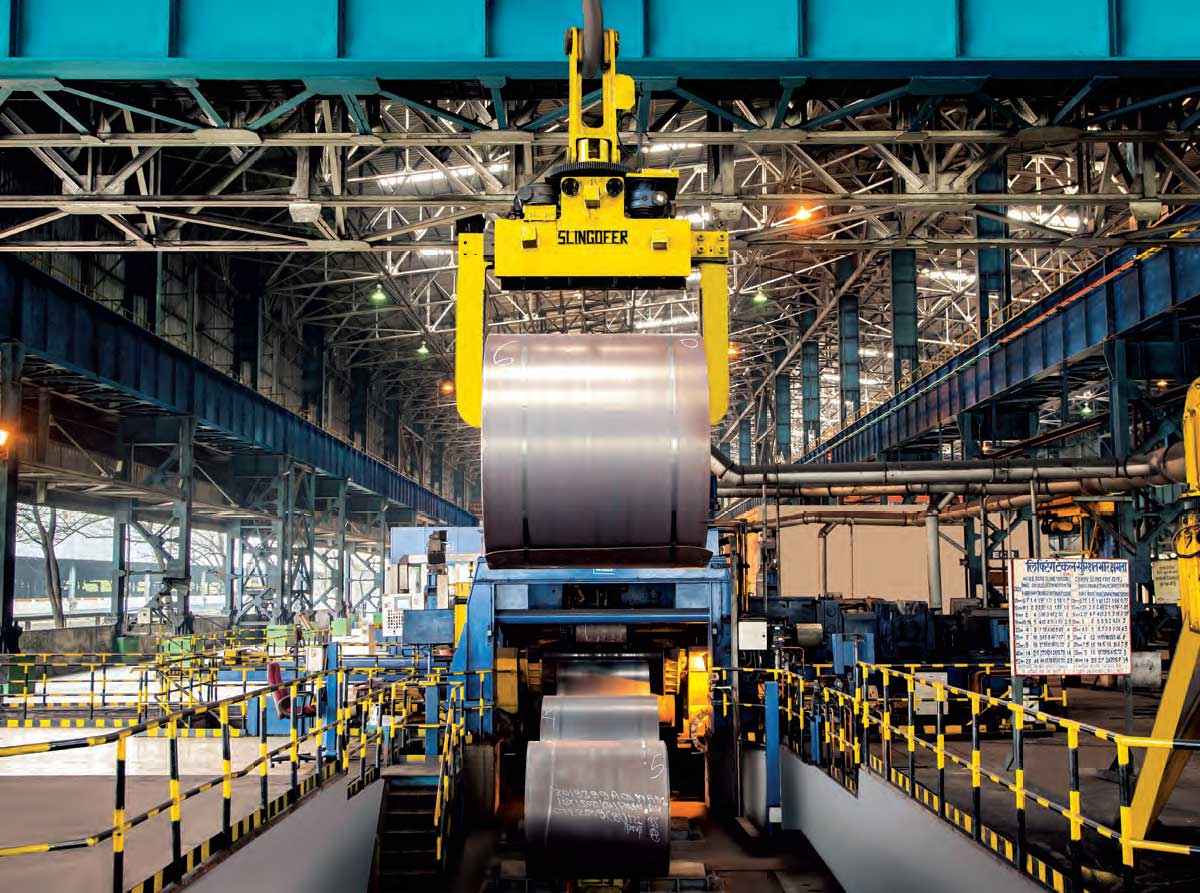India is currently the world’s second largest producer of crude steel producing 118.20 mt. The country is the largest producer of direct reduced iron (DRI) or sponge iron in the world (January-December 2021), producing 39.04 mt of sponge iron, with a growth rate of 16.2 per cent over the corresponding period last year. India is also the 2nd largest consumer of finished steel in 2021 (106.23 mt), preceded by China as the largest steel consumer, as per the World Steel Association. Capacity for domestic crude steel expanded from 137.97 mt in 2017-18 to 154.06 mt in 2021-22, with a CAGR of 3.7 per cent during the five-year period. Production of steel could go up to 500 mt by 2050, nearly four times the current output.Steel has traditionally occupied a top spot among metals and is seen as a measure of the country’s economic development because it is both a raw material and an intermediary product. The Indian steel industry is classified into three categories: major producers, main producers and secondary producers. Growth in the Indian steel sector is driven by the domestic availability of raw materials such as iron ore and cost-effective labour. Consequently, the steel sector has been a major contributor to the country’s manufacturing output. The Indian steel industry is modern, with state-of-the-art steel mills, and strives for continuous modernisation of older plants and upgradation to higher energy-efficiency levels.The construction sector is the pan-India driver of steel demand in the country, buoyed by a strong government thrust on infrastructure development and housing for all. Government initiatives such as Smart Cities and affordable housing as well as building of industrial corridors will boost India’s steel demand, leading to enhanced connectivity, reduced logistical costs and well-distributed development spanning all Indian states. Further, Make in India aims to transform India into a global design and manufacturing hub, with sectors along the industrial and freight corridors. Several Indian states are expected to set up automotive and ancillary industries to become global hubs for manufacturing export-oriented small cars.Fastest Growing Steel CompanyJINDAL STEEL & POWER Jindal Steel & Power (JSPL), part of the $18 billion OP Jindal Group, is one of India’s fastest-growing and largest integrated steel manufacturers, with a significant presence in steel, power, mining and infrastructure in Asia, Africa and Australia. Led by Naveen Jindal, the company manufactures and sells sponge iron, mild steel slabs, rails, mild steel, structural and hot-rolled plates, iron ore pellets and coils. It is the third-largest private steel producer in India.It has a product portfolio that caters to markets across the steel value chain, produces the world’s longest rails (121 m) and is the first in India to manufacture large-size parallel flange beams.The company has set up the world’s first coal gasification-based DRI plant in Angul, Odisha. The plant uses locally available high-ash coal and turns it into synthesis gas for steelmaking, reducing dependence on imported coke-rich coal. It has two more manufacturing facilities at Barbil, Odisha and Patratu, Jharkhand. The pellet plant at Barbil has a total installed capacity of 9 mtpa for different pellet grades, with a dry grinding facility that harnesses the recuperation type of straight grate technology. The manufacturing plant at Patratu has a finished steel capacity of 1.6 mtpa.The Company is rated as the world’s second-highest value creator by the Boston Consulting Group, the 11th fastest growing company in India by Business World, and has figured in the Forbes Asia list of ‘Fab 50’ companies. It has been ranked 4th by Dun & Bradstreet in its list of companies that generated the highest total income in the iron and steel sector. It has also been named amongst the Best BlueChipCompanies and rated as the Highest Wealth Creator by Dalal Street Journal. For FY2022-23, the company reported gross revenue of Rs 589.70 billion, compared to Rs 551.84 billion in FY2021-22. PAT stood at Rs 24.27 billion, compared to Rs 82.83 billion the previous year.TATA STEEL Established in India as Asia’s first integrated private steel company in 1907, Tata Steel Ltd is among the leading global steel companies with an annual crude steel capacity of 34 mtpa. One of the world’s most geographically diversified steel producers, it has developed India’s first industrial city in Jamshedpur. Tata Steel has been recognised by WorldSteel as a Sustainability Champion for the sixth time in a row and by the World Economic Forum as a ‘Global Diversity, Equity & Inclusion Lighthouse’.Tata Steel has one of the few steel operations that is fully integrated – from mining to manufacturing and marketing of finished products. With its subsidiaries, associates and JVs, it is spread across five continents. Its product portfolio is divided into four segments: Automotive and Special Products; Industrial Products, Projects and Exports; Branded Products and Retail; and Services and Solutions. It supplies hot-rolled, cold rolled and galvanised branded offerings. The company has set up its second greenfield steel plant of 8 mtpa in Odisha. It possesses and operates captive mines that help it maintain cost-competitiveness and production efficiencies through an uninterrupted supply of raw material, ensuring it remains the lowest-cost producer of steel in Asia. Continuous improvement in its product and service portfolio, with success in value-creating initiatives for customers, allows it to serve global growth markets and have a commercial presence across the world.In FY2022-23, its consolidated revenues stood at `2,433.53 billion, broadly similar on a year-on-year (YoY) basis, despite a volatile operating environment across geographies. Consolidated EBITDA stood at `326.98 billion, with an EBITDA margin of ~13 per cent, and consolidated PAT stood at Rs 80.75billion. India achieved its highest-ever annual crude steel production of 19.88 mt and highest-ever deliveries of 18.87 mt, driving product mix improvement. During the year, the Automotive segment increased 5 per cent YoY and Branded Products and Retail were higher by 11per cent YoY, while Industrial Products and projects increased 14 per cent YoY.The phased commissioning of Tata Steel’s expansion in Kalinganagar continues with FHCR coils now being produced at the CRM complex. Further, within nine months of acquisition, it has successfully ramped up NeelachalIspat Nigam Ltd to ~1 mt on an annualised basis. It has also progressed on its plans to set up its first EAF mill in Punjab.STEEL AUTHORITY OF INDIA Steel Authority of India Ltd (SAIL) is one of the largest steelmaking companies in India and one of the Maharatnas of the country’s central public-sector enterprises (CPSEs). It is under the ownership of the Ministry of Steel, with the Government owning about 65 per cent of its equity and retaining voting control. By virtue of its Maharatna status, it enjoys significant operational and financial autonomy. Engaged primarily in the manufacture and sale of iron and steel products, it is one of India’s largest steel producers with around 17.43 mt of hot metal and 16.15 mt of crude steel production. It produces iron and steel at five integrated plants and three special steel plants located primarily in eastern and central India and situated close to domestic sources of raw materials. SAIL manufactures and sells a broad range of steel products. The third-largest steel producer in India by output plans to more than double the capacity of the IISCO Steel Plant (ISP) in Burnpur, while the Durgapur Steel Plant (DSP) will also witness significant additions. After the last round of modernisation and expansion, the capacity of IISCO was raised to 2.5 mtpa. SAIL has now firmed up plans to increase capacity by another 4.5 mt, taking installed capacity to 7 mt. As the Maharatna readies itself for major expansions in Burnpur and Durgapur, Bengal will be a big beneficiary of its ambitious growth plans. In FY2022-23, the company reported revenue of Rs 1,044.47 billion, compared to Rs 1,034.73 billion in FY2021-22. EBITDA was Rs 93.79 billion, compared to Rs 223.64 billion, while PAT stood at Rs 19.03 billion, compared to Rs 12.02 billion in the previous year. Crude steel production stood at 18.29 mt, compared to 17.37 mt, while total sales amounted to 16.20 mt, against 16.15 mt.


















